Working closely with AWS partnership teams, we have now made RLCatalyst Research Gateway (SaaS) available on AWS Marketplace for seamless consumption. Available on a tiered user-based pricing model, you can continue using your existing AWS accounts.
Click here for the full story.
Today, the growing need for remote working, cloud-based assets, and touchless interactions have amplified the importance of automated user onboarding and offboarding. By leveraging existing investments in common ITSM tools, AWS Control Services, and with a pre-existing library of commonly used Relevance Lab’s BOTs, customers can quickly achieve end-to-end automation.
Click here for the full story.
Relevance Lab’s RLCatalyst Research Gateway on AWS acts as a bridge providing seamless & secure interaction for personas, access to programs & budgets with the ability to consume and manage the lifecycle of research-related computational and data resources. It provides frictionless and intelligent interactions between the system.
Click here for the full story.
RLCatalyst Research Gateway provides scientists and research professionals simplification of cloud adoption while speeding up their research with proper cost & budget controls and secure governance for research programs. Built on AWS & leveraging the best practices, the portal makes research simpler, faster, and better.
Click here for the full story.
2021 Blog, Blog, Featured
AWS Marketplace is a high-potential delivery mechanism for the delivery of software and professional services. The main benefit for customers is that they get a single bill from AWS for all their Infrastructure and Software consumption. Also, since AWS is already on the approved vendor list for many enterprises, it makes it easier for enterprises to consume software also from the same vendor.
Relevance Lab has always considered AWS Marketplace as one of the important channels for the distribution of its software products. In 2020 we had listed our RLCatalyst 4.3.2 BOTs Server product on the AWS Marketplace as an AMI-based product that a customer could download and run in their AWS account. This year, RLCatalyst Research Gateway was listed on the AWS Marketplace as a Software as a Service (SaaS) product.
This blog details some of the steps that a customer needs to go through to consume this product from the AWS Marketplace.
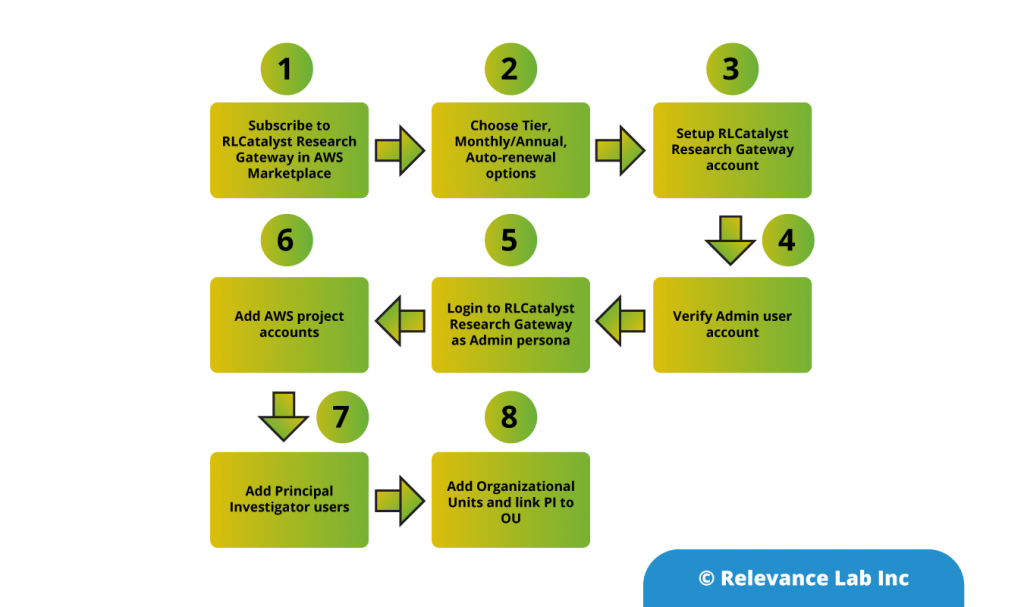
Step 1: The first step for a customer looking to find the product is to log in to their account and visit the AWS Marketplace. Then search for RLCatalyst Research Gateway. This will show the Research Gateway product at the top of the list in the results. Click on the link and this should lead to the details page.
The product details page lists the important details like.
- Pricing information
- Support information
- Set up instructions
Step-2: The second step for the user is to subscribe to the product by clicking on the “Continue to Subscribe” button. This step will need the user to login into their AWS account (if not done earlier). The page which comes up will show the contract options that the user can choose. RLCatalyst Research Gateway (SaaS) offers three tiers for subscription.
- Small tier (1-10 users)
- Medium tier (11-25 users)
- Large tier (unlimited users)
Also, the customer has the option of choosing a monthly contract or an annual contract. The monthly contract is good for customers who want to try the product or for those customers who would like a budget outflow that is spread over the year rather than a lump sum. The annual contract is good for customers who are already committed to using the product in the long term. An annual contract gets the customer an additional discount over the monthly price.
The customer also has to choose whether they want to contract to renew automatically or not.
One of the great features of AWS Marketplace is that the customer can modify the contract at any time and upgrade to a higher plan (e.g. Small tier to Medium or Large tier). The customer can also modify the contract to opt for auto-renewal at any time.
Step-3: The third step for the user is to click on the “Subscribe” button after choosing their contract options. This leads the user to the registration page where they can set up their RLCatalyst Research Gateway account.
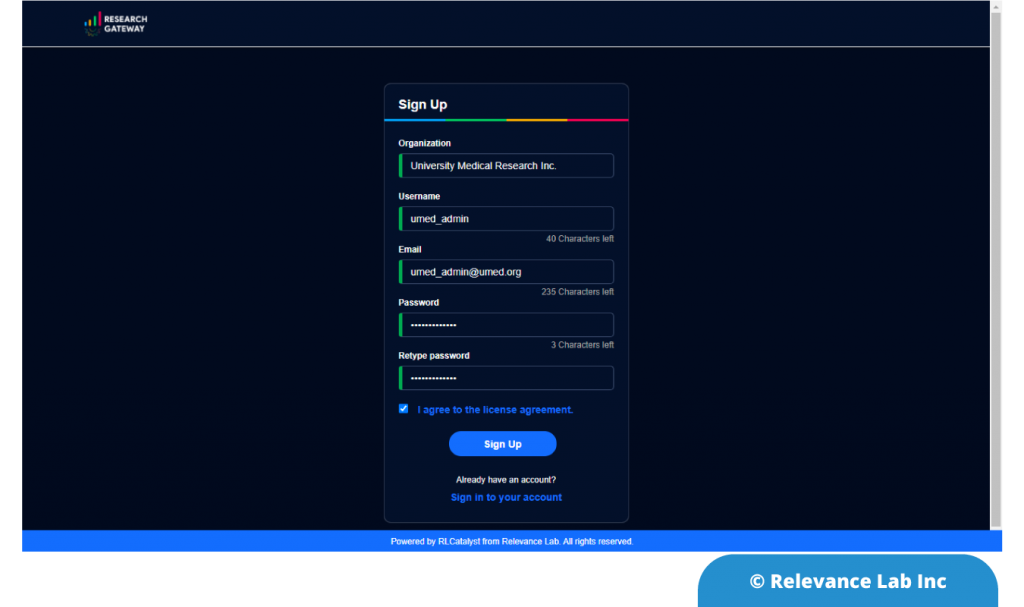
This screen is meant for the Administrator persona to enter the details for the organization. Once the user enters the details, agrees to the End User License Agreement (EULA), and clicks on the Sign-up button, the process for provisioning the account is set in motion. The user should get an acknowledgment email within 12 hours and an email verification email within 24 hours.
Step-4: The user should verify their email account by clicking on the verification link in the email they receive from RLCatalyst Research Gateway.
Step-5: Finally, the user will get a “Welcome” email with the details of their account including the custom URL for logging into his RLCatalyst Research Gateway account. The user is now ready to login into the portal. On logging in to the portal the user will see a Welcome screen.
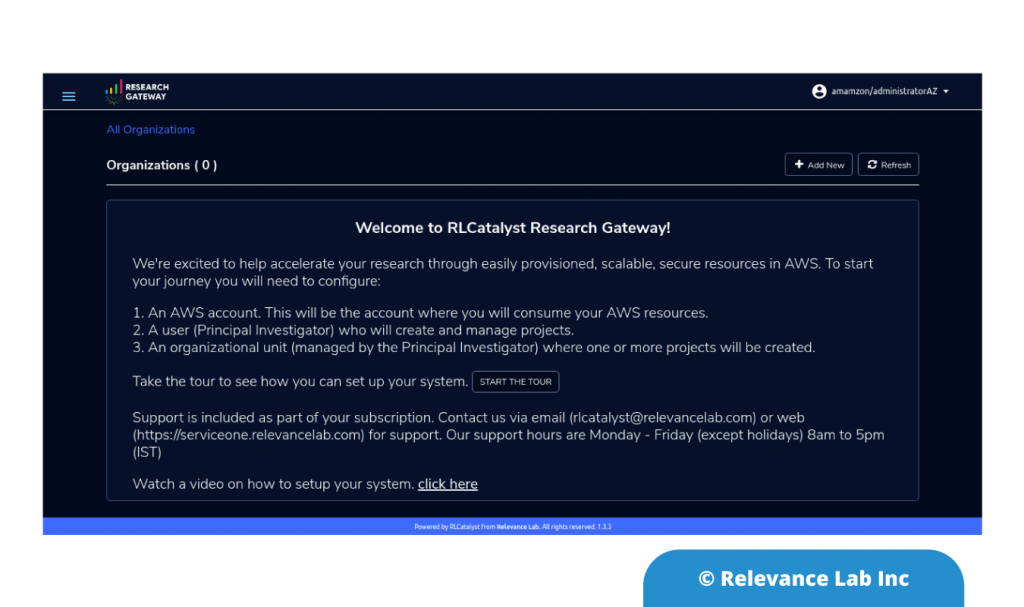
Step-6: The user can now set up their first Organizational Unit in the RLCatalyst Research Gateway portal by following these steps.
6.1 Navigate to settings from the menu at the top right.

6.2 Click on the “Add New” button to add an AWS account.

6.3 Enter the details of the AWS account.
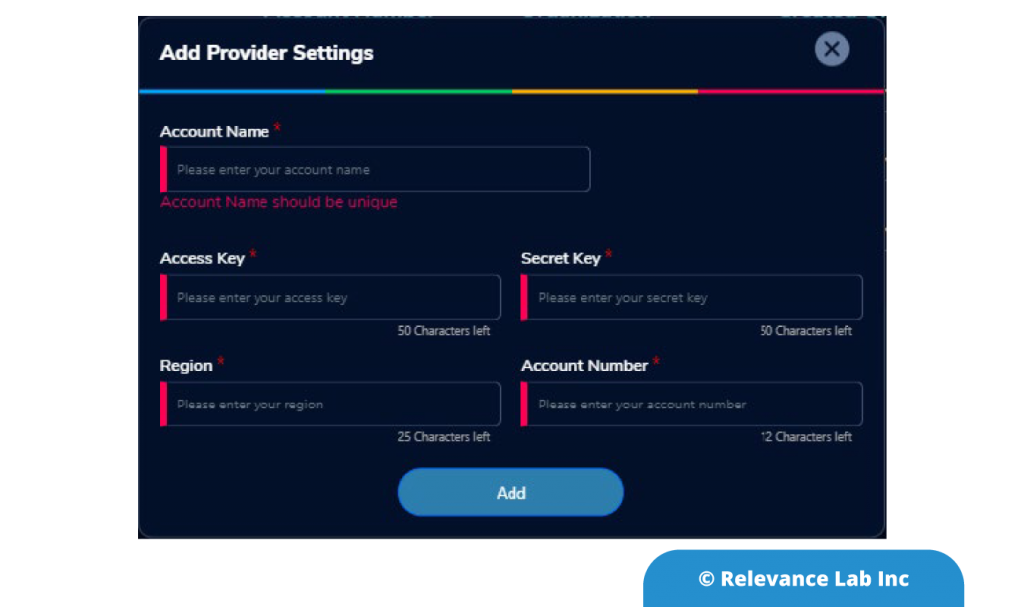
Note that the account name given in this screen is any name that will help the Administrator to remember which OU and project this account is meant for.
6.4 The Administrator can repeat the procedure to add more than one project (consumption) account.
Step-7: Next the Administrator needs to add Principal Investigator users to the account. For this, he should contact the support team either by email (rlc.support@relevancelab.com) or by visiting the support portal (https://serviceone.relevancelab.com).
Step-8: The final step to set up an OU is to click on the “Add New” button on the Organizations page.

8.1 The Administrator should give a friendly name to the Organization in the “Organization Name” field. Then he should choose all the Accounts that will be consumed by projects in this account. A friendly description should be entered in the “Organization Description” field. Finally, choose a Principal Investigator who will manage/own this Organization Unit. Click “Add Organization” to add this OU.
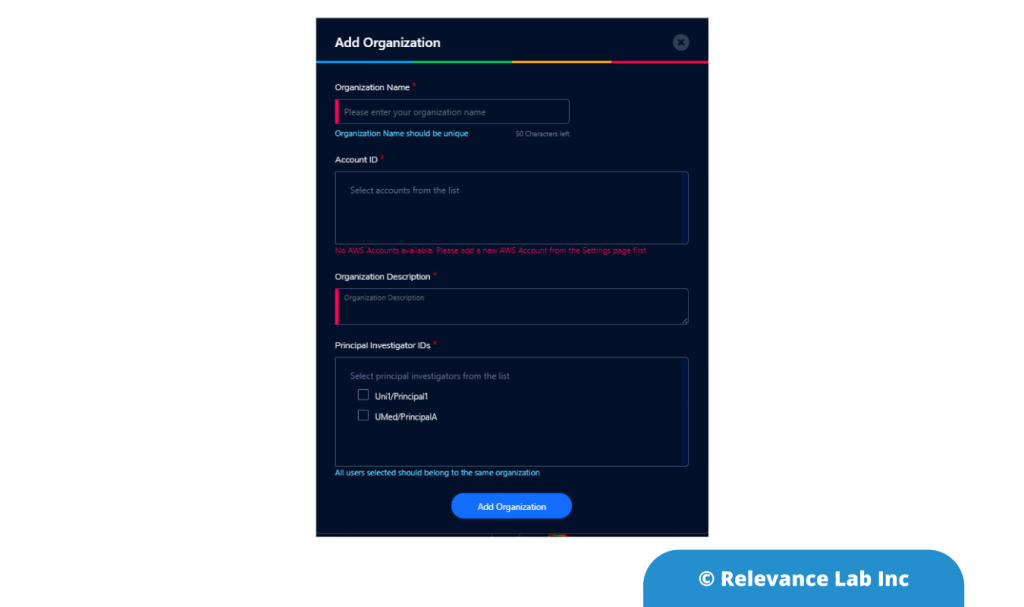
Summary
As you can see above, ordering RLCatalyst Research Gateway (SaaS) from the AWS Marketplace makes it extremely easy for the user to get started, and end-users can start using the product within no time. Given the SaaS model, the customer does not need to worry about setting up the software in their account. At the same time, using their AWS account for the projects gives them complete transparency into the budget consumption.
In our next blog, we will provide step by step details of adding organizational units, projects & users to complete the next part of setup.
To learn more about AWS Marketplace installation click here.
If you want to learn more about the product or book a live demo, feel free to contact marketing@relevancelab.com.
Relevance Lab has proudly partnered with Sri Chaitanya Trust for CSR activities. We have utilized our funds for strengthening the Fight against Covid-19 and gifting Clear Vision to Senior Citizens.
Click here for the full story.
Solving real-world scientific research problems requires deep domain understanding, access to public data sets, and complex computation analysis with advanced visualizations. Leveraging the Cloud computing and RLCatalyst Research Gateway, we explain simplifying the process with a common use case for Earth Sciences Atmosphere modelling and analysis.
Click here for the full story.
2021 Blog, Blog, Featured
Working on non-scientific tasks such as setting up instances, installing software libraries, making model compile, and preparing input data are some of the biggest pain points for atmospheric scientists or any scientist for that matter. It’s challenging for scientists as it requires them to have strong technical skills deviating them from their core areas of analysis & research data compilation. Further adding to this, some of these tasks require high-performance computation, complicated software, and large data. Lastly, researchers need a real-time view of their actual spending as research projects are often budget-bound. Relevance Lab help researchers “focus on science and not servers” in partnership with AWS leveraging the RLCatalyst Research Gateway (RG) product.
Why RLCatalyst Research Gateway?
Speeding up scientific research using AWS cloud is a growing trend towards achieving “Research as a Service”. However, the adoption of AWS Cloud can be challenging for Researchers with surprises on costs, security, governance, and right architectures. Similarly, Principal Investigators can have a challenging time managing the research program with collaboration, tracking, and control. Research Institutions will like to provide consistent and secure environments, standard approved products, and proper governance controls. The product was created to solve these common needs of Researchers, Principal Investigator and Research Institutions.
- Available on AWS Marketplace and can be consumed in both SaaS as well as Enterprise mode
- Provides a Self-Service Cloud Portal with the ability to manage the provisioning lifecycle of common research assets
- Gives a real time visibility of the spend against the defined project budgets
- The principal investigator has the ability to pause or stop the project in case the budget is exceeded till the new grant is approved
In this blog, we explain how the product has been used to solve a common research problem of GEOS-Chem used for Earth Sciences. It covers a simple process that starts with access to large data sets on public S3 buckets, creation of an on-demand compute instance with the application loaded, copying the latest data for analysis, running the analysis, storing the output data, analyzing the same using specialized AI/ML tools and then deleting the instances. This is a common scenario faced by researchers daily, and the product demonstrates a simple Self-Service frictionless capability to achieve this with tight controls on cost and compliance.
GEOS-Chem enables simulations of atmospheric composition on local to global scales. It can be used off-line as a 3-D chemical transport model driven by assimilated meteorological observations from the Goddard Earth Observing System (GEOS) of the NASA Global Modeling Assimilation Office (GMAO).
The figure below shows the basic construct on GEOS-Chem input and output analysis.
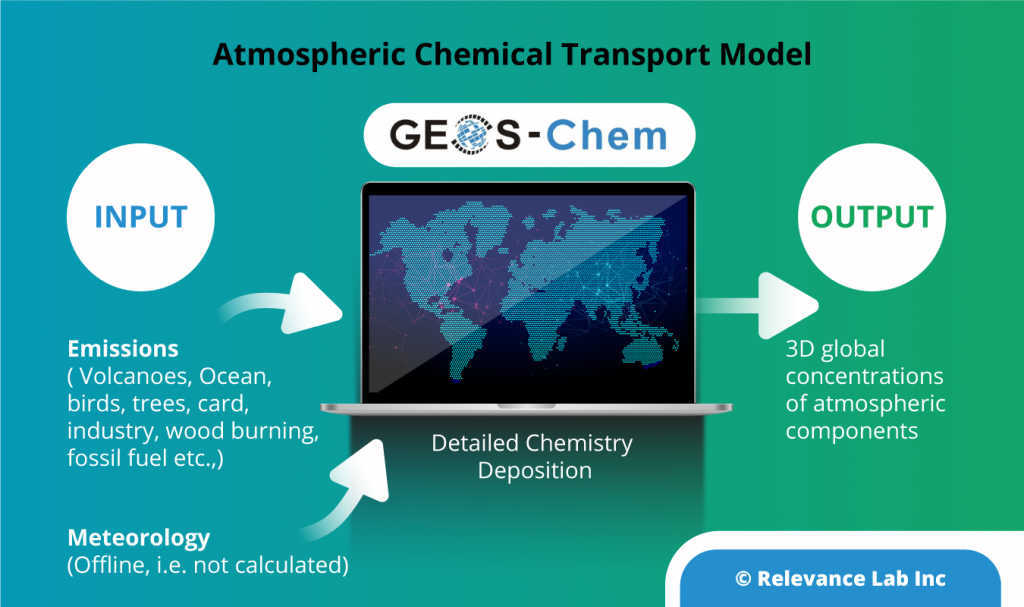
Being a common use case, there is documentation available in the public domain by researchers on how to run GEOS-Chem on AWS Cloud. The product makes the process simpler using a Self-Service Cloud portal. To know more about similar use cases and advanced computing options, refer to AWS HPC for Scientific Research.
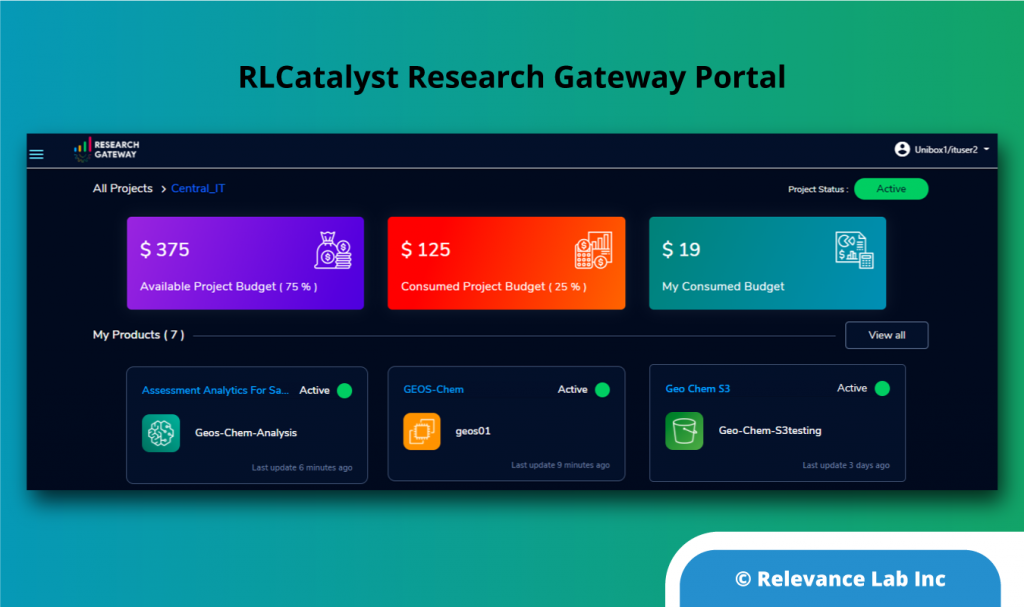
Steps for GEOS-Chem Research Workflow on AWS Cloud
Prerequisites for researcher before starting data analysis.
- A valid AWS account and an access to the RG portal
- A publicly accessible S3 bucket with large Research Data sets accessible
- Create an additional EBS volume for your ongoing operational research work. (For occasional usage, it is recommended to upload the snapshot in S3 for better cost management.)
- A pre-provisioned SageMaker Jupyter notebook to analyze output data
Once done, below are the steps to execute this use case.
- Login to the RG Portal and select the GEOS-Chem project
- Launch an EC2 instance with GEOS-Chem AMI
- Login to EC2 using SSH and configure AWS CLI
- Connect to a public S3 bucket from AWS CLI to list NASA-NEX data
- Run the simulation and copy the output data to a local S3 bucket
- Link the local S3 bucket to AWS SageMaker instance and launch a Jupyter notebook for analysis of the output data
- Once done, terminate the EC2 instance and check for the cost spent on the use case
- All costs related to GEOS-Chem project and researcher consumption are tracked automatically
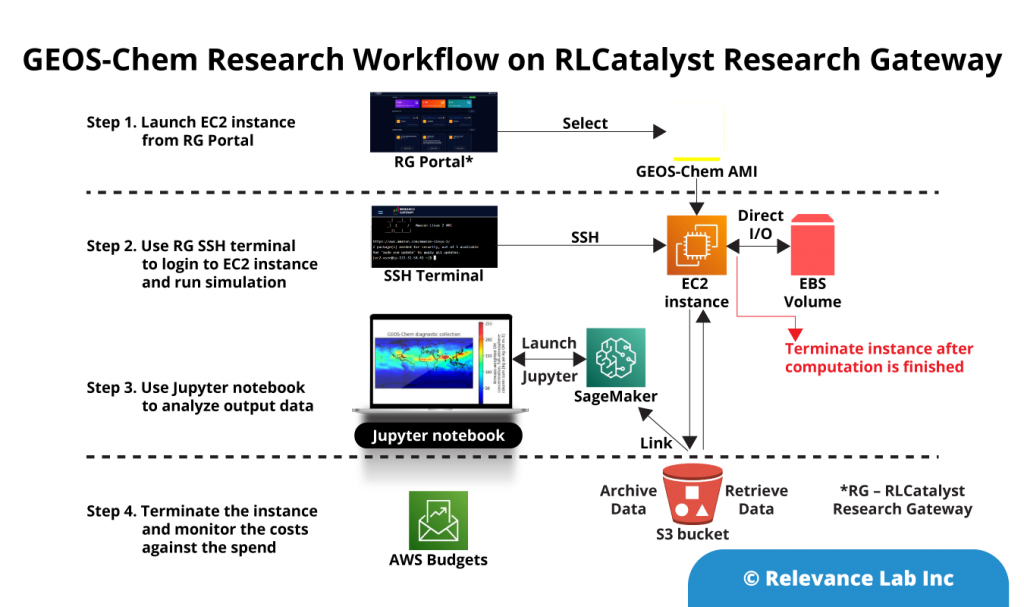
Sample Output Analysis
Once you run the output files on the Jupyter notebook, it does the compilation and provides output data in a visual format, as shown in the sample below. The researcher can then create a snapshot and upload it to S3 and terminate the EC2 instance (without deleting the additional EBS volume created along with EC2).
Output to analyze loss rate and Air mass of Hydroxide pertaining to Atmospheric Science.
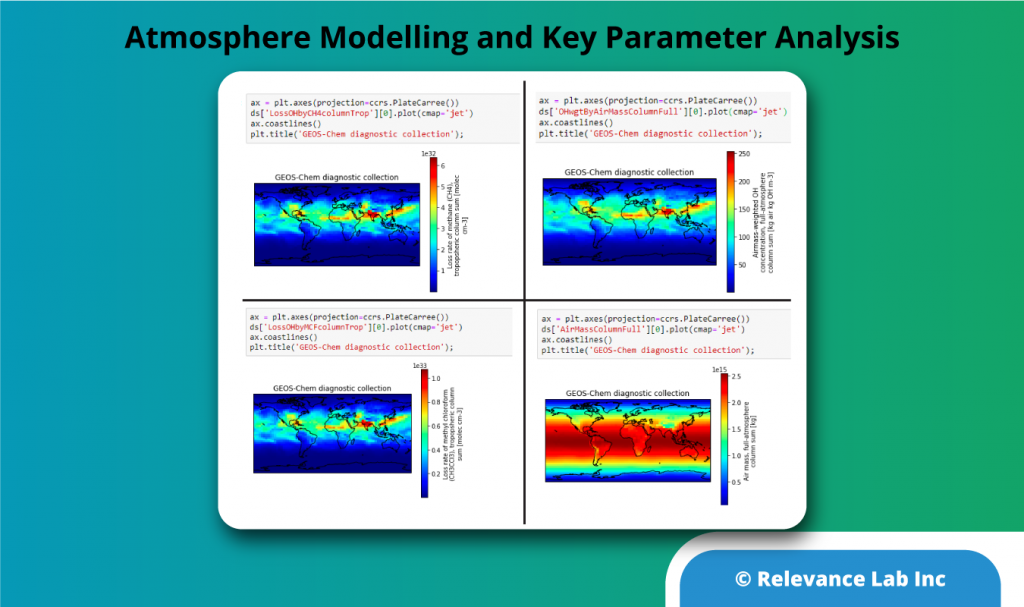
Summary
Scientific computing can take advantage of cloud computing to speed up research, scale-up computing needs almost instantaneously, and do all this with much better cost-efficiency. Researchers no longer need to worry about the expertise required to set up the infrastructure in AWS as they can leave this to tools like RLCatalyst Research Gateway, thus compressing the time it takes to complete their research computing tasks.
The steps demonstrated in this blog can be easily replicated for similar other research domains. Also, it can be used to onboard new researchers with pre-built solution stacks provided in an easy to consume option. RLCatalyst Research Gateway is available in SaaS mode from AWS Marketplace and research institutions can continue to use their existing AWS account to configure and enable the solution for more effective Scientific Research governance.
To learn more about GEOS-Chem use cases, click here.
If you want to learn more about the product or book a live demo, feel free to contact marketing@relevancelab.com.
References
Enabling Immediate Access to Earth Science Models through Cloud Computing: Application to the GEOS-Chem Model
Enabling High‐Performance Cloud Computing for Earth Science Modeling on Over a Thousand Cores: Application to the GEOS‐Chem Atmospheric Chemistry Model
